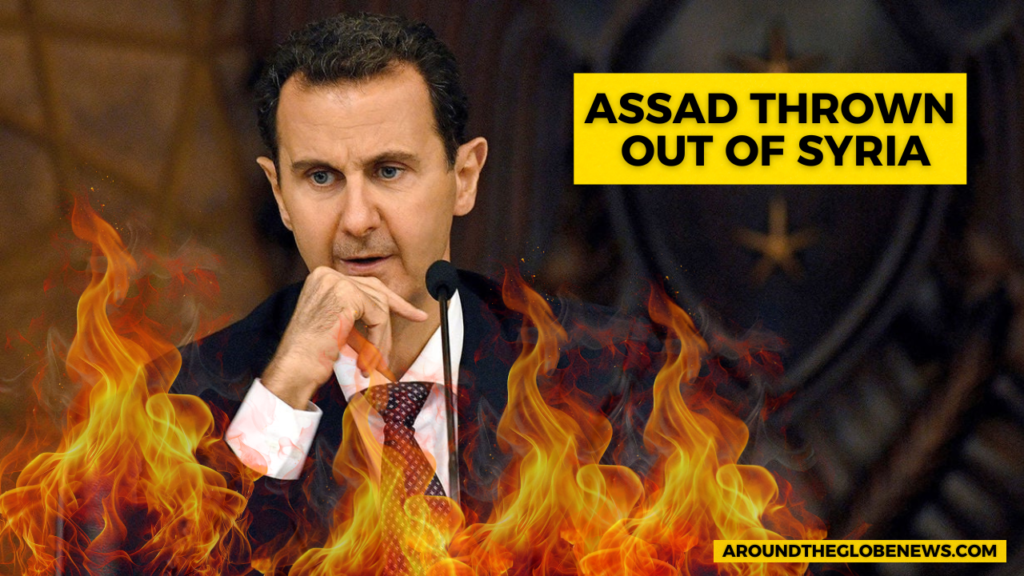Syrian Rebels Seize Damascus as Assad Flees to Russia Ending Assad’s Rule After 13-Year Civil War

In a dramatic turn of events on Sunday, Syrian rebels captured the capital city of Damascus without resistance, marking the end of President Bashar al-Assad‘s regime after a 13-year civil war and six decades of his family’s authoritarian rule. Reports suggest Assad fled to Russia, seeking asylum after his government’s unexpected collapse.
This development signals a seismic shift in the Middle East, dismantling a key base of influence for both Iran and Russia. Mikhail Ulyanov, Russia’s ambassador to international organizations in Vienna, confirmed on Telegram that Assad and his family were now in Moscow.
The swift ousting of Assad’s government, propelled by a rebellion with backing from Turkey and ties to Sunni Islamist movements, disrupts Iran’s supply networks to its regional allies and jeopardizes Russia’s naval foothold in the Mediterranean. For millions of displaced Syrians in camps across Turkey, Lebanon, and Jordan, this could pave the way for their long-awaited return home.
For Syrians, the fall of Assad brought an abrupt end to years of suffering under a stagnant war that claimed hundreds of thousands of lives, reduced cities to rubble, and devastated the nation’s economy.
At Damascus’s historic Umayyad Mosque, rebel leader Abu Mohammed al-Golani addressed a jubilant crowd, reflecting on the war’s toll: “How many lived in tents? How many drowned seeking safety?” He declared the victory a turning point for the region, envisioning Syria as a future symbol of hope for the Islamic world.
End of an Era of Oppression
The Assad regime, notorious for its brutal suppression of dissent since the 1960s, collapsed overnight. Thousands of political prisoners, long held in some of the region’s most infamous prisons, were freed as rebels took control. Videos captured elated former detainees running through the streets of Damascus, their freedom symbolized by raised hands showing the years they had endured behind bars.
Rebels also targeted Sedhaya prison, a notorious facility, deploying rescue teams to locate hidden cells believed to contain additional detainees.
‘The sun of freedom has risen.’
Syria’s opposition fighters have overthrown Bashar al-Assad after taking control of the capital Damascus following 13 years of war. pic.twitter.com/Dd8lxZeePd
— Al Jazeera English (@AJEnglish) December 8, 2024
Symbolic Scenes in Damascus
As Damascus transitioned into rebel control, iconic images emerged. Roads once bustling with military checkpoints were deserted, and rebel vehicles roamed the streets. Posters of Assad were defaced, and a military truck burned near the city’s outskirts. In Mazzeh, smoke billowed from areas struck earlier by Israeli forces, reportedly targeting Syrian security sites.
Even the opulent Al-Rawda Presidential Palace was breached. People were seen walking away with furniture, and a motorcycle was parked casually in its once-immaculate halls.
Syrians celebrating in Latakia were filmed riding around on a toppled statue of former president Hafez al-Assad, Bashar’s father, as it was dragged through the streets. pic.twitter.com/C6hsxXndaI
— Al Jazeera English (@AJEnglish) December 8, 2024
Transition of Power Begins
The Syrian rebel coalition announced its intent to establish a transitional governing body. In a statement, they emphasized unity and the immense task of rebuilding a nation shattered by conflict. Meanwhile, Mohammad Ghazi al-Jalali, Assad’s former prime minister, called for free elections and held discussions with Golani about the transitional phase.
Golani, whose group once had ties to al-Qaeda but has since sought to project a more moderate image, pledged to uphold the revolutionary ideals, declaring there would be no turning back.
Global Reactions and Regional Shockwaves
The rapid fall of Assad’s regime sent shockwaves across the Arab world and raised concerns about potential instability. U.S. President Joe Biden lauded the regime’s collapse as a significant moment but cautioned about the risks ahead. “The United States will collaborate with partners to help navigate this uncertain but hopeful transition,” he said.
The U.S. Central Command confirmed airstrikes targeting Islamic State operatives in Syria, while Defense Secretary Lloyd Austin reassured Turkey of continued U.S. vigilance.
Meanwhile, jubilant celebrations erupted among Syrian expats worldwide. Embassies saw Assad-era flags replaced with the opposition’s banner. Israeli Prime Minister Benjamin Netanyahu credited Assad’s fall to successful Israeli strikes against Iran and Hezbollah, while French President Emmanuel Macron hailed the end of Assad’s “barbaric state.”
The Challenges Ahead
Syria’s new leadership faces the herculean task of stabilizing a diverse nation and securing billions in international aid for reconstruction. The civil war, which began in 2011 as an uprising, left behind a humanitarian crisis of unprecedented scale, with millions displaced and infrastructure in ruins.
For Russia and Iran, Assad’s fall marks a strategic defeat. Both nations had heavily invested in propping up his regime, with military and financial support. However, shifting global dynamics and internal pressures, such as Russia’s focus on Ukraine, diminished their ability to sustain Assad’s rule.
As Syria embarks on its next chapter, the region braces for the profound consequences of this historic moment.
Also Read : Kashmir : A Quick and Handy Travel Guide